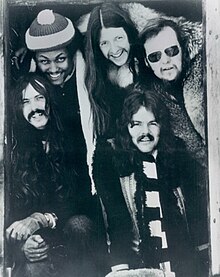The Doobie Brothers
| The Doobie Brothers | |
|---|---|

The Doobie Brothers in 1974 (l–r): Knudsen, Porter, Simmons, Johnston (front), Hartman
|
|
| Background information | |
| Also known as | The Doobies |
| Origin | San Jose, California, U.S. |
| Genres | |
| Years active |
|
| Labels | |
| Associated acts | |
| Website | doobiebros |
| Members |
|
| Past members | See members section |
The Doobie Brothers is an American rock band. The group has sold more than 40 million albums worldwide throughout its career. The band has been active for five decades, with their biggest success occurring in the 1970s.
The band's history can be roughly divided into three eras. From 1969 to 1975 they featured lead vocalist Tom Johnston and featured a mainstream rock and roll sound with elements of folk, country and R&B. Johnston quit the group in 1975, and was replaced with Michael McDonald whose interest in soul music changed the sound of the band until they broke up in 1982. The Doobie Brothers reformed in 1987 with Johnston back in the fold and are active to the present with occasional contributions from McDonald. Every incarnation of the group emphasized vocal harmonies from the band's members. The Doobie Brothers were inducted into the Vocal Group Hall of Fame in 2004.
Drummer John Hartman arrived in California in 1969 determined to meet Skip Spence of Moby Grape and join an aborted Grape reunion. Spence introduced Hartman to singer, guitarist, and songwriter Tom Johnston and the two proceeded to form the nucleus of what would become the Doobie Brothers. Johnston and Hartman called their fledgling group "Pud" and experimented with lineups (occasionally including Spence) and styles as they performed in and around San Jose. They were mostly a power trio (along with bassist Greg Murphy) but briefly worked with a horn section.
In 1970, they teamed up with singer, guitarist, and songwriter Patrick Simmons and bass guitarist Dave Shogren. Simmons had belonged to several area groups (among them "Scratch", an acoustic trio with future Doobies bassist Tiran Porter) and also performed as a solo artist. He was already an accomplished fingerstyle player whose approach to the instrument complemented Johnston's rhythmic R&B strumming.
...
Wikipedia
